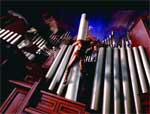
Church battle: Pixel Magic used After Effects for compositing. Action scenes called for both wire removal and digital characters.
|
TOLUCA LAKE. CA - It's a strange but familiar world the new Daredevil occupies. Especially if you're familiar with brooding, misunderstood heroes with odd complexes and their own brand of justice. Guys who alight on precarious architectural precipices so they can absorb the urban decay below them and silently curse their fates.
Yes, it's New York. More precisely, Daredevil's setting is not far from the Javits Center, a precinct better known in its Marvel Comics days as Hell's Kitchen. Still, Ben Affleck's lawyer/superhero gets around much of the city despite his lack of eyesight. And director Mark Steven Johnson sees he gets into plenty of fights, including a couple with a woman.

Rhythm & Hues used Side Effects Houdini to help develop the wrinkling effect of Daredevil's leather suit.
|
We moviegoers get to experience the world as the hyper-sensitive Daredevil perceives it, and it's a chillingly beautiful place of pulsing pale blues. Loud sounds pound his ears, but also provide radar-like impressions of objects' shapes and proximity. And visible odors also waft toward him, describing new characters and familiar ones, including his martial-artist love interest. Rhythm & Hues (www.rhythm.com) is largely responsible for visualizing the world as Daredevil sees it, creating volumetric effects in Houdini software.
But back to the fighting: Pixel Magic, based here, had initially taken on overflow wire removal and compositing work but, as is sometimes the case with effects-intensive films, their workload ballooned to 125 shots during the course of production - a goodly portion of the 400-plus total.
GOING TO CHURCH
After performing such work for about a month, Pixel Magic (www. pixelmagicfx.com) bid on and secured the job of building a CG version of the church interior that serves as the setting of Daredevil's climactic face-off with Bullseye (Colin Farrell), an expert at throwing pointy things with deadly effectiveness. (Bullseye is also adept at throwing shurikens - razor-sharp discs created in CG and composited by Pixel Magic.)
For the church battle, Rich Thorne, the film's VFX director for Fox, wanted a 300-foot-high church with massive organ pipes reaching high above the foes' heads. Pixel Magic's digital effects supervisor Tyler Foell and CG supervisor Mike Hardison obliged by building the interior in NewTek LightWave and Alias|Wavefront Maya, based on precise information from a Lidar scan of a real, but much smaller, church. "Lidar is a mesh of points, scanned from many different angles in the church," says Hardison."It's converted into geometry. We used it both in Maya and in LightWave. We did most of our modeling in LightWave," he adds, citing that they were more comfortable with the software. The Pixel Magic team was able to easily transfer the Lidar church geometry back and forth between LightWave and Maya. "We took some of our tracking through Maya in order to sync up with some of the tracking that was done in compositing. We would export our RealViz [Matchmover files] through Maya and through LightWave, further refine it, and send it off to our compositing department for additional layers."
"Rich Thorne had us build a church and we broke it into several different sections," says Foell. "We composited a lot of the show in After Effects and input the Maya track, and then we could do additional camera moves, add camera shake and move the church in 3D space based on that track. Not only did our greenscreen characters have a camera move on them, that we'd have to track and match our CG church too, and additionally, within compositing, we broke it up and added camera moves."
"It involves augmenting an original plate with additional parallax and 3D perspective," adds Hardison.
STUNT WORK
But there are more stunts done by real actors than you would suspect. Much of Daredevil's martial arts stunts are about deft wire removal. "We did about 60 wire removals" Foell says, although there were some shots in the church battle involving CG versions of the characters done by Rhythm & Hues. "In all of our shots the actors were on wires performing the stunts."
But Daredevil doesn't just fight bald guys. And Pixel Magic had an opportunity to re-create Elektra, Daredevil's female friend, in CG. In one stunt, where Elektra faces Bullseye and has to jump a wall, she becomes a hybrid, part actress Jennifer Garner, part CG, and then seamlessly becomes all CG. (Elektra is due to get her own feature film says 20th Century Fox.)
Elektra first meets Daredevil in his blind lawyer guise in a daytime scene set in a schoolyard. The encounter quickly escalates into a somewhat playful display of each character's ability to defy gravity. But the daylight setting and the presence of school children leaves little in the way of forgiving shadows. "There was some extraordinarily tough wire work on that," says Foel.They also added a CG cane.
So, has Crouching Tiger and The Matrix put a new focus on actors doing their own stunts, rather than digital doubles? "I think that it's incredibly tough to get a performance out of a CG character," says Foell.
Hardison, the CG supervisor, agrees: "You want to get as much [live action] on film as you can and you let post pick up the pieces where it's not successful."